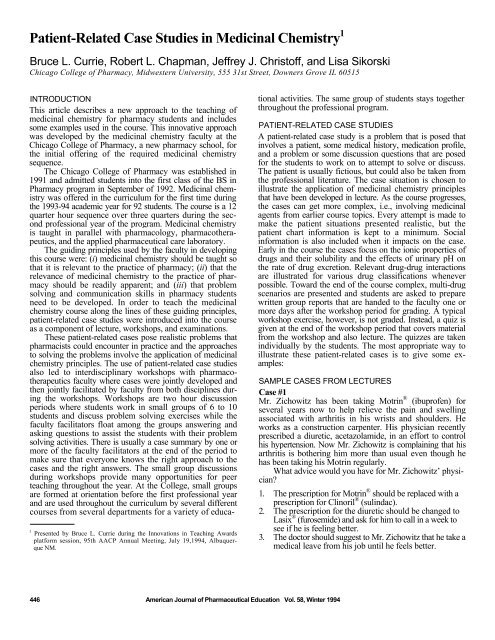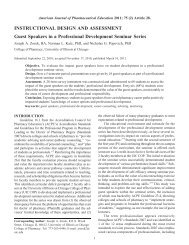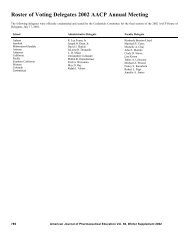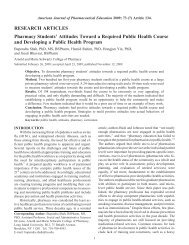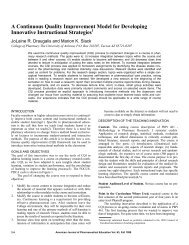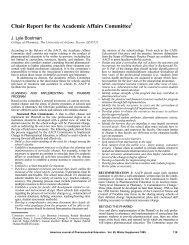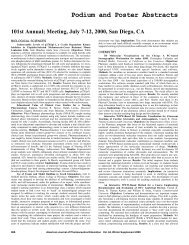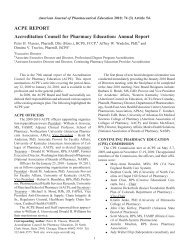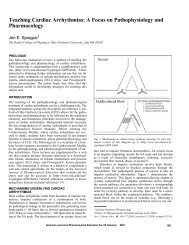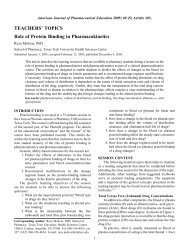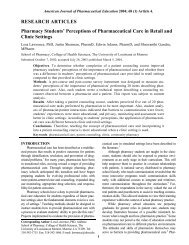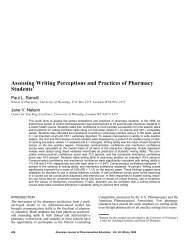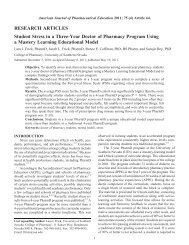Patient-Related Case Studies In Medicinal Chemistry - AJPE
Patient-Related Case Studies In Medicinal Chemistry - AJPE
Patient-Related Case Studies In Medicinal Chemistry - AJPE
You also want an ePaper? Increase the reach of your titles
YUMPU automatically turns print PDFs into web optimized ePapers that Google loves.
<strong>Patient</strong>-<strong>Related</strong> <strong>Case</strong> <strong>Studies</strong> in <strong>Medicinal</strong> <strong>Chemistry</strong> 1<br />
Bruce L. Currie, Robert L. Chapman, Jeffrey J. Christoff, and Lisa Sikorski<br />
Chicago College of Pharmacy, Midwestern University, 555 31st Street, Downers Grove IL 60515<br />
INTRODUCTION<br />
This article describes a new approach to the teaching of<br />
medicinal chemistry for pharmacy students and includes<br />
some examples used in the course. This innovative approach<br />
was developed by the medicinal chemistry faculty at the<br />
Chicago College of Pharmacy, a new pharmacy school, for<br />
the initial offering of the required medicinal chemistry<br />
sequence.<br />
The Chicago College of Pharmacy was established in<br />
1991 and admitted students into the first class of the BS in<br />
Pharmacy program in September of 1992. <strong>Medicinal</strong> chemistry<br />
was offered in the curriculum for the first time during<br />
the 1993-94 academic year for 92 students. The course is a 12<br />
quarter hour sequence over three quarters during the second<br />
professional year of the program. <strong>Medicinal</strong> chemistry<br />
is taught in parallel with pharmacology, pharmacotherapeutics,<br />
and the applied pharmaceutical care laboratory.<br />
The guiding principles used by the faculty in developing<br />
this course were: (i) medicinal chemistry should be taught so<br />
that it is relevant to the practice of pharmacy; (ii) that the<br />
relevance of medicinal chemistry to the practice of pharmacy<br />
should be readily apparent; and (iii) that problem<br />
solving and communication skills in pharmacy students<br />
need to be developed. <strong>In</strong> order to teach the medicinal<br />
chemistry course along the lines of these guiding principles,<br />
patient-related case studies were introduced into the course<br />
as a component of lecture, workshops, and examinations.<br />
These patient-related cases pose realistic problems that<br />
pharmacists could encounter in practice and the approaches<br />
to solving the problems involve the application of medicinal<br />
chemistry principles. The use of patient-related case studies<br />
also led to interdisciplinary workshops with pharmacotherapeutics<br />
faculty where cases were jointly developed and<br />
then jointly facilitated by faculty from both disciplines during<br />
the workshops. Workshops are two hour discussion<br />
periods where students work in small groups of 6 to 10<br />
students and discuss problem solving exercises while the<br />
faculty facilitators float among the groups answering and<br />
asking questions to assist the students with their problem<br />
solving activities. There is usually a case summary by one or<br />
more of the faculty facilitators at the end of the period to<br />
make sure that everyone knows the right approach to the<br />
cases and the right answers. The small group discussions<br />
during workshops provide many opportunities for peer<br />
teaching throughout the year. At the College, small groups<br />
are formed at orientation before the first professional year<br />
and are used throughout the curriculum by several different<br />
courses from several departments for a variety of educa-<br />
1 Presented by Bruce L. Currie during the <strong>In</strong>novations in Teaching Awards<br />
platform session, 95th AACP Annual Meeting, July 19,1994, Albuquerque<br />
NM.<br />
tional activities. The same group of students stays together<br />
throughout the professional program.<br />
PATIENT-RELATED CASE STUDIES<br />
A patient-related case study is a problem that is posed that<br />
involves a patient, some medical history, medication profile,<br />
and a problem or some discussion questions that are posed<br />
for the students to work on to attempt to solve or discuss.<br />
The patient is usually fictious, but could also be taken from<br />
the professional literature. The case situation is chosen to<br />
illustrate the application of medicinal chemistry principles<br />
that have been developed in lecture. As the course progresses,<br />
the cases can get more complex, i.e., involving medicinal<br />
agents from earlier course topics. Every attempt is made to<br />
make the patient situations presented realistic, but the<br />
patient chart information is kept to a minimum. Social<br />
information is also included when it impacts on the case.<br />
Early in the course the cases focus on the ionic properties of<br />
drugs and their solubility and the effects of urinary pH on<br />
the rate of drug excretion. Relevant drug-drug interactions<br />
are illustrated for various drug classifications whenever<br />
possible. Toward the end of the course complex, multi-drug<br />
scenarios are presented and students are asked to prepare<br />
written group reports that are handed to the faculty one or<br />
more days after the workshop period for grading. A typical<br />
workshop exercise, however, is not graded. <strong>In</strong>stead, a quiz is<br />
given at the end of the workshop period that covers material<br />
from the workshop and also lecture. The quizzes are taken<br />
individually by the students. The most appropriate way to<br />
illustrate these patient-related cases is to give some examples:<br />
SAMPLE CASES FROM LECTURES<br />
<strong>Case</strong> #1<br />
Mr. Zichowitz has been taking Motrin ® (ibuprofen) for<br />
several years now to help relieve the pain and swelling<br />
associated with arthritis in his wrists and shoulders. He<br />
works as a construction carpenter. His physician recently<br />
prescribed a diuretic, acetazolamide, in an effort to control<br />
his hypertension. Now Mr. Zichowitz is complaining that his<br />
arthritis is bothering him more than usual even though he<br />
has been taking his Motrin regularly.<br />
What advice would you have for Mr. Zichowitz’ physician?<br />
1. The prescription for Motrin ® should be replaced with a<br />
prescription for Clinoril ® (sulindac).<br />
2. The prescription for the diuretic should be changed to<br />
Lasix ® (furosemide) and ask for him to call in a week to<br />
see if he is feeling better.<br />
3. The doctor should suggest to Mr. Zichowitz that he take a<br />
medical leave from his job until he feels better.<br />
446 American Journal of Pharmaceutical Education Vol. 58, Winter 1994
4. The dose of Motrin® should be doubled this week and<br />
then doubled again next week if there is no improvement<br />
with a caution to be aware of possible stomach<br />
irritation.<br />
<strong>Case</strong> #2<br />
You are a recently hired pharmacist at Southwestern DuPage<br />
Community Hospital. You have been assigned to work in<br />
the IV room. Everything was going fine until today when<br />
you started making up a solution of anticonvulsant drugs<br />
that had been requested for a pediatric patient that was<br />
having severe and frequent convulsions. The preparation<br />
called for making 1 liter of a solution containing 2 g of<br />
Dilantin sodium and 500 mg Depakene® in normal saline.<br />
You started by making a solution of Dilantin® sodium in<br />
saline, but when you added the Depakene® a voluminous<br />
precipitate formed.<br />
What is the problem and what can you do about it?<br />
1. Put the IV bag in the autoclave and heat it at 80° C for<br />
1 hour to dissolve the precipitate.<br />
2. Put the IV bag on a shaker and shake the mixture until<br />
the precipitate dissolves.<br />
3. <strong>In</strong>crease the volume of normal saline to 2 liters to<br />
improve the solubility of the mixture.<br />
4. Ask the physician to change one of the ingredients, and<br />
make a recommendation of Tegretol® (carbamazepine)<br />
in place of Dilantin® sodium.<br />
SAMPLE CASES FROM EXAMS<br />
<strong>Case</strong> #1<br />
Mr. B.D. Taste approaches you at the prescription counter<br />
in ClinPharm Assoc. with a prescription for an ACE inhibitor,<br />
captopril (structure shown), written by Dr. Jones. <strong>In</strong><br />
reviewing your patient profile records you find that Mr. B .T.<br />
was previously treated for hyperthyroidism two years ago by<br />
Dr. Zik using propylthiouracil (structure shown). At that<br />
time, B.T. complained of a bad taste in his mouth (like really<br />
bad burnt garlic) within two hours of taking his PTU and he<br />
also developed a severe rash on his forearms. His thyroid<br />
condition has since been corrected with surgery.<br />
1. You have available in your pharmacy captopril, enalapril<br />
maleate, and lisinopril as ACE inhibitors. Should you<br />
call Dr. Jones or dispense as written? Discuss. If you<br />
decide to call Dr. Jones, what will be your recommendation?<br />
2. Discuss briefly the role of an ACE inhibitor with regard<br />
to the renin-angiotensin system. <strong>In</strong> the structures of the<br />
three ACE inhibitors you have in stock, circle the<br />
functional group which is most critical for the action as<br />
an ACE inhibitor.<br />
<strong>Case</strong> #2<br />
Sally Doright is a 45 year old housewife who has decided to<br />
take some classes at a local junior college. She has been<br />
thinking that she might complete the requirements for prepharmacy<br />
so she can go to pharmacy school and become a<br />
pharmacist, now that her two children are grown and living<br />
on their own. She has chronic allergy problems and regularly<br />
takes chlorpheniramine (ChlorTrimeton®), especially in<br />
the autumn during ragweed and goldenrod season when she<br />
usually doubles her normal dose of two tablets per day. This<br />
past September she visited her regular physician for a checkup<br />
before school started. The physician discovered that Sally<br />
was suffering from mild hypertension and placed her on<br />
acetazolamide (Diamox®) to see if the hypertension could<br />
be managed readily. A follow up visit two weeks later<br />
indicated that the hypertension was now under control.<br />
However, Sally is routinely falling asleep during her morning<br />
classes at school, even in her favorite subject, Organic<br />
<strong>Chemistry</strong>. (Structures given for medications.)<br />
Identify any problem situations regarding the medications<br />
that Sally is receiving. Develop a recommendation for the<br />
physician regarding appropriate drug therapy and briefly<br />
justify your recommendation.<br />
GROUP CASE WORKSHOPS<br />
<strong>Case</strong> #1<br />
Mrs. X.Z. is a 68 y.o. female who has been seen in the<br />
hypertension clinic because of continuing problems controlling<br />
her blood pressure (currently her BP 150/100). You, as<br />
the pharmacist associated with the clinic, are called in to<br />
consult because of the large of number of prescription and<br />
OTC meds that the patient is taking as the result of seeing<br />
several physicians as well as self-medication. The patient's<br />
medication history reveals treatment for hypothyroidism<br />
(levothyroxine, 0.1 mg), diabetes (Humulin R, 10 units and<br />
Humulin N, 20 units 30-60 min. before breakfast and Humulin<br />
American Journal of Pharmaceutical Education Vol. 58, Winter 1994 447
R, 10 units 30-60 min. before dinner), cardiovascular disease<br />
(clofibrate, 500 mg qid; propranolol, 20 mg q8h; captopril,<br />
12.5 mg q8h; aspirin, 325 mg qod; warfarin, 7.5 mg qd), and<br />
post-menopausal osteoporosis (DES, 0.25 rag qd x 21 then<br />
7 days off, repeat). Mrs. Z. also keeps ibuprofen (2 x 200mg<br />
prn) on hand for frequent headaches.<br />
Mrs. Z. recently retired from a full-time job as a production<br />
supervisor in a local manufacturing plant. As a result of<br />
her various ailments and “just being tired”, her husband is<br />
doing most of the housework and cooking all of the meals.<br />
She reports poor compliance with her physician’s recommended<br />
diet and exercise program.<br />
1. Examine all of the medications that Mrs. Z. is taking.<br />
State briefly the mechanism of action for each and the<br />
appropriateness of the choice of therapy for the disease<br />
indication.<br />
2. Identify any real or potential adverse drug reactions<br />
based on the medication profile.<br />
3. Identify any potential changes in drug therapy recommendations<br />
(from several physicians) based on evaluating<br />
all of the disease indications and the patient’s recent<br />
change of lifestyle.<br />
4. Make a new comprehensive drug therapy and patient<br />
education recommendation based on your assessment<br />
above. If there are areas where more information is<br />
needed or follow-up monitoring is warranted, then<br />
specify accordingly.<br />
<strong>Case</strong> #2<br />
P.Y. is a 57 y.o.w.f. with advanced epithelial ovarian cancer<br />
that is refractory to cisplatin (CBC, renal and hepatic function<br />
WNL). Following consult the patient was enlisted in the<br />
institutions taxol protocol.<br />
Taxol (Paclitaxel ® ) is supplied to the institution as a<br />
concentrated sterile solution of 6 mg/mL in 5 mL ampules.<br />
The vehicle is 50 percent polyoxyethylated castor oil<br />
(Cremophore EL ® ) and 50 percent dehydrated alcohol,<br />
USP. One-third of the total taxol dose is prepared in each of<br />
three 1000 mL bottles of 5 percent Dextrose <strong>In</strong>jection, USP.<br />
Following pre-medication (see below), P.Y. was to receive<br />
her first dose of taxol. 135 mg/m 2 infused IV over 24<br />
hours. P.Y. was also to receive recombinant granulocytecolony-stimulating<br />
factor (G-CSF), 10 mg/kg/d from 24<br />
hours after the taxol infusion was stopped until her total<br />
granulocyte count was > 1500/mL on two successive determinations(1).<br />
Pre-medication regimen:<br />
Dexamethasone, 20 mg IV 14 h and 7 h prior to taxol.<br />
Diphenhydramine 50 mg IV 30 min. prior to taxol.<br />
Famotidine 20 mg IV 30 min. prior to taxol.<br />
1. What is the mechanism of action for each drug (taxol,<br />
dexamethasone, diphenhydramine and famotidine), and<br />
what is the rationale behind the pretreatment regimen?<br />
2. Based on the inclusion of G-CSF in the protocol, what<br />
would you propose as a major side effect of taxol?<br />
Within two minutes of beginning the taxol infusion,<br />
P.Y. developed bradycardia, severe chest pain, diaphoresis<br />
and respiratory distress. The taxol infusion was stopped and<br />
P.Y.s condition returned to normal, except for the cancer<br />
being treated. Five hours later, P.Y. was given another 20 mg<br />
dose of IV dexamethasone, followed in 30 minutes by<br />
diphenhydramine 50 mg IV and famotidine 20 mg IV. The<br />
taxol infusion was begun again at a rate 10 percent that of the<br />
original rate for two hours, gradually increasing to the<br />
original infusion rate over the next three hours. After five<br />
additional taxol treatments repeated every 21 days without<br />
sequelae. P.Y. is in a state of remission.<br />
3. What is (are) the major contributing factor(s) to the<br />
success of re-challenging the patient with this taxol<br />
protocol?<br />
STUDENT FEEDBACK AND EVALUATION OUTCOMES<br />
Feedback from students was invited in two basic ways. First a<br />
questionnaire was prepared that all students were asked to<br />
respond to anonymously and was constructed in a graded<br />
response format from 1 to 5. Summaries of some of the<br />
responses are discussed later in this paper. A second type of<br />
feedback was an invited essay by one representative from<br />
each of the eleven small student groups. These were each<br />
one to two pages in length. Space does not permit inclusion<br />
of all of these statements verbatim. However, one of the<br />
students (LS) prepared a composite of the cogent comments<br />
made by the various groups in their reflective statements.<br />
This composite is included below preceded by some quotes<br />
from individual essays.<br />
Quotes<br />
“Being able to work through these activities with a small<br />
group provides interaction and knowledge exchange that<br />
lecture cannot normally provide.”<br />
‘These chemistry workshops prepare us as pharmacists to<br />
face situations head on, and to rationally identify and solve<br />
them. This is an important part of our careers, and I personally<br />
feel better prepared to undertake these challenges.”<br />
“These workshops, however, are not without some faults.<br />
The workshops depend on each individual group to be able<br />
to communicate effectively among themselves. If personalities<br />
clash, it could turn into a shouting match!”<br />
“By allowing time for the group to discuss the cases before<br />
reviewing the answers, the group members are free to<br />
hypothesize and create solutions to the problems. Whether<br />
or not these answers are correct, there is one guarantee ...<br />
we will understand the chemistry behind the answers before<br />
we leave the workshop.’”<br />
“When working on a case, medicinal chemistry becomes<br />
connected to the other subjects pharmacy students are<br />
studying. Concepts already learned are reinforced from a<br />
new perspective and new concepts augment the learning in<br />
other courses.”<br />
“I believe working as a group is challenging, as well as a great<br />
resource. Each individual has a strength that is unique and<br />
that trait is brought forth in workshops.”‘<br />
“<strong>In</strong>stead of trying to remember interaction after interaction, I<br />
have been taught to critically evaluate each structure and<br />
determine not only how it will work, but also how it will<br />
interact with other molecules.”<br />
“Applying what you have learned is the most important skill<br />
to have when leaving college. The cases in medicinal chemistry<br />
have taught me to apply chemistry knowledge to practical<br />
situations and hopefully will enable me to become a<br />
more effective pharmacist.”<br />
448 American Journal of Pharmaceutical Education Vol. 58, Winter 1994
Table I. Student opinions on workshops and cases in <strong>Medicinal</strong> <strong>Chemistry</strong><br />
Question<br />
Strongly<br />
agree<br />
Agree Neutral Disagree Strongly<br />
disagree<br />
4. The instructional approach and use of a combination<br />
of lectures and workshops is effective in helping me to<br />
learn the subject. 15 37 19 2 2<br />
5. The use of patient-related case studies in workshop is<br />
effective as a means to relate course subject matter to<br />
applications in the practice of pharmacy. 17 46 5 6 1<br />
6. The patient-related cases that are a component of<br />
workshops in medicinal chemistry are appropriate<br />
problem-solving exercises. 16 44 10 4 1<br />
7. The inclusion of patient-related cases on examinations<br />
was a good means of evaluation of my understanding of<br />
course material. 14 39 18 3 1<br />
8. The use of small groups as the basis for the discussions in the<br />
workshop is useful for my learning of the subject material. 8 31 22 9 5<br />
9. Ai! of the members of my small group participate in discussions<br />
pertaining to the workshop tasks during the workshop period. 3 19 16 26 10<br />
10. All of the members of my small group make important<br />
contributions to the outcomes of the learning experience<br />
during the workshop. 0 25 17 24 8<br />
11. I understand medicinal chemistry better as a result of the<br />
workshop component of this course. 5 38 22 8<br />
1<br />
12. There should be more workshops during the medicinal<br />
chemistry sequence. 0 23 23 23 6<br />
13. Overall, I think that workshops helped me to learn more<br />
effectively in medicinal chemistry. 12 36 19 4 3<br />
COMPOSITE REFLECTIVE STATEMENT FROM A<br />
STUDENTS PERSPECTIVE<br />
The prevailing attitude among students regarding the use of<br />
small groups throughout their coursework at CCP is generally<br />
positive. They have expressed that small group learning<br />
has been a means of fostering interpersonal communication,<br />
which can then be utilized in their future careers as health<br />
professionals. The process of expressing individual opinions<br />
and realizing that there is more than one way to solve a<br />
problem, are first steps to establish the open-mindedness<br />
needed for effective teamwork. This teamwork, as recognized<br />
by the students, is an important trait among health<br />
professionals. The utilization of dialogue is necessary to<br />
achieve the optimal patient outcomes. Thus, the utilization<br />
of small group discussions in various courses, including<br />
<strong>Medicinal</strong> <strong>Chemistry</strong>, serves to prepare CCP students for<br />
future interactions with fellow health professionals.<br />
Through the use of <strong>Medicinal</strong> <strong>Chemistry</strong> workshops to<br />
augment weekly lectures, students have expressed that the<br />
class has been made “less intimidating.” <strong>In</strong> the workshop<br />
setting, the students welcome the opportunity to discuss the<br />
material learned with their peers on a simpler level. This<br />
setting facilitates “peer teaching” and also allows for more<br />
individualized contact with the professor, who is there to<br />
offer any assistance needed. The students feel that both of<br />
these aspects enhance the material learned in lecture. Too<br />
often students may have trouble understanding what is<br />
presented while they are not in the right environment to<br />
openly discuss it.<br />
It is also recognized by the students that the workshop<br />
setting, where each group tackles a problem and attempts to<br />
solve it, will help prepare them to be more effective pharmacists,<br />
since it teaches them to rationally identify and solve<br />
complex problems. Like the use of patient-related cases,<br />
workshops help to initiate the critical thinking process,<br />
which is lost when rote memorization alone is emphasized.<br />
The students appreciate this attempt at forcing them to<br />
think critically and investigatively, for it will benefit them in<br />
the future in their practice setting.<br />
The use of patient-related cases in <strong>Medicinal</strong> <strong>Chemistry</strong><br />
lectures, workshops, and examinations has met with considerable<br />
approval from the students. One common opinion<br />
expressed involved the idea that <strong>Medicinal</strong> <strong>Chemistry</strong> was<br />
made more “relevant” to the overall pharmacy curriculum.<br />
<strong>Medicinal</strong> <strong>Chemistry</strong>, in the students’ perspective, can easily<br />
be thought of as an isolated part of pharmacy study which<br />
is irrelevant to common practice. Through the use of patient-related<br />
cases, the students have expressed that they<br />
now realize exactly how the application of <strong>Medicinal</strong> <strong>Chemistry</strong><br />
is an integral part of the basic understanding of drug<br />
therapy. With having to evaluate a patient case and using<br />
American Journal of Pharmaceutical Education Vol. 58, Winter 1994 449
medicinal chemistry to solve the drug therapy problem<br />
presented, the students feel they are forced to critically<br />
evaluate the chemical structures and apply that knowledge<br />
to the solution. This process replaces the otherwise tedious<br />
task of memorizing structures and drug interactions, which<br />
does not facilitate true understanding of the drug action. By<br />
presenting <strong>Medicinal</strong> <strong>Chemistry</strong> in this way, the students<br />
feel they are understanding the true relevance of the chemical<br />
structure of the drugs they learn, rather than viewing<br />
them as an accessory to the lists of mechanisms and interactions<br />
they would otherwise memorize.<br />
A survey of the PS-II Class was conducted in order to<br />
get focused feedback regarding the anonymous opinions of<br />
students concerning the use of patient-related cases in the<br />
medicinal chemistry course. Summaries of some of the data<br />
from this survey are found in Table I. A copy of the entire<br />
survey is included in the Appendix.<br />
DISCUSSIONS<br />
There are relatively few reports of the incorporation of<br />
patient-related case studies as problem-solving exercises in<br />
pharmaceutical science courses. Duncan-Hewitt(2) and<br />
Sims(3) have recently reported on the use of patient-related<br />
cases as an aid to teaching pharmaceutics. Sims(4) has also<br />
used them in teaching pharmacokinetics. Roche(5) is the<br />
only example of the use of patient-related cases as a component<br />
of teaching medicinal chemistry. Roche used them as<br />
application questions on examinations. This manuscript is<br />
the first to describe a broad application of case problemsolving<br />
throughout a required course in medicinal chemistry,<br />
e.g., lecture, workshop, quizzes, and examinations. Based<br />
on the positive responses from students, this approach to<br />
teaching medicinal chemistry has considerable potential. It<br />
has also provided a good avenue for collaboration with the<br />
pharmacotherapeutics faculty resulting in the joint development<br />
and facilitation of some cases in workshop.<br />
CONCLUSIONS<br />
1. <strong>Patient</strong>-related cases and workshops seem to be useful<br />
for teaching medicinal chemistry.<br />
2. Feedback from students is generally quite favorable.<br />
3. The approach taken will continue to be modified and<br />
expanded.<br />
4. Developing patient-related cases has been challenging<br />
and fun for the faculty involved.<br />
5. This approach to teaching medicinal chemistry promotes<br />
interdisciplinary cooperation, particularly with<br />
faculty in pharmacotherapeutics.<br />
Am. J. Pharm. Educ., 58, 446-450(1994); received 9/30/94.<br />
References<br />
(1) Peereboom, D.M., Donehower, R.C., Eisenhauer, E.A., McGuire,<br />
W.P., Onetto, N., Hubbard, J.L., Piccart, M., Gianni,L., and Rowinsky,<br />
E.K., “Successful retreatment with taxol after major hypersensitivity reactions,”<br />
J. Clin. Oncol., 11, 885-890(1993).<br />
(2) Duncan-Hewitt, W.C., “Formulation problem-solving as an alternative<br />
to traditional pharmaceutics,” Am. J. Pharm. Educ., 56, 242-<br />
251(1992).<br />
(3) Sims, P J., “Utilizing the peer group method with case studies to teach<br />
pharmaceutics,” ibid., 58, 78-81(1994).<br />
(4) Sims, P J., “Utilizing the peer group method with case studies to teach<br />
pharmacokinetics,” ibid., 58, 73-77(1994).<br />
(5) Roche, V.F., “The use of case studies in medicinal chemistry instruction,”<br />
ibid., 57, 436-439(1993).<br />
APPENDIX<br />
Questionnaire/Evaluation of Workshops and <strong>Case</strong> <strong>Studies</strong> as a<br />
Part of the <strong>Medicinal</strong> <strong>Chemistry</strong> Course Sequence<br />
<strong>In</strong>structions: This is an anonymous questionnaire. Please mark the<br />
scantron sheet only as Med Chem Workshop. Please respond to the<br />
following statements according to the scale: A = Strongly Agree; B<br />
= Agree; C = Neutral; D = Disagree; E = Strongly Disagree<br />
1. <strong>Medicinal</strong> <strong>Chemistry</strong> is the one course in the PS-II curriculum<br />
that I found to be the easiest to understand.<br />
2. Pre-pharmacy coursework prepared me effectively for the<br />
subject matter of the <strong>Medicinal</strong> <strong>Chemistry</strong> sequence.<br />
3. The PS-I curriculum prepared me effectively to study and<br />
learn <strong>Medicinal</strong> <strong>Chemistry</strong> as a part of the pharmacy curriculum.<br />
4. The instructional approach used in <strong>Medicinal</strong> <strong>Chemistry</strong>, use<br />
of a combination of lectures and workshops, is effective in<br />
helping me to learn the subject.<br />
5. The use of patient-related case studies as a component of the<br />
workshop in <strong>Medicinal</strong> <strong>Chemistry</strong> is effective as a means to<br />
relate course subject matter to applications in the practice of<br />
pharmacy.<br />
6. The patient-related cases that are a component of workshops<br />
in <strong>Medicinal</strong> <strong>Chemistry</strong> arc appropriate problem-solving exercises.<br />
7. The inclusion of patient-related cases on examinations was a<br />
good means of evaluation of my understanding of course<br />
material.<br />
8. The use of small groups as the basis for the discussions in the<br />
workshop in <strong>Medicinal</strong> <strong>Chemistry</strong> is useful for my learning of<br />
the subject matter.<br />
9. All of the members of my small group participate in discussions<br />
pertaining to the workshop tasks in <strong>Medicinal</strong> <strong>Chemistry</strong><br />
during the workshop period.<br />
10. All of the members of my small group make important contributions<br />
to the discussions and outcomes of the learning experiences<br />
during the workshop in <strong>Medicinal</strong> <strong>Chemistry</strong>.<br />
11. I understand <strong>Medicinal</strong> <strong>Chemistry</strong> better as a result of the<br />
workshop component of the course.<br />
12. There should be more workshops during the <strong>Medicinal</strong> <strong>Chemistry</strong><br />
sequence.<br />
13. Overall, I think that workshops helped me to learn more<br />
effectively in <strong>Medicinal</strong> <strong>Chemistry</strong>.<br />
Note Different Response Scale<br />
14. The grades that I received in <strong>Medicinal</strong> <strong>Chemistry</strong> are generally<br />
A = higher than; B = about the same as; C = usually lower<br />
than; grades that I received in other courses during the PS-II<br />
year of the curriculum.<br />
Please use the space below for any additional comments that you<br />
wish to make regarding the use of patient-related cases for problem-solving<br />
exercises in <strong>Medicinal</strong> <strong>Chemistry</strong> and/or the use of<br />
workshops as a means of learning and applying <strong>Medicinal</strong> <strong>Chemistry</strong>.<br />
450 American Journal of Pharmaceutical Education Vol. 58, Winter 1994


